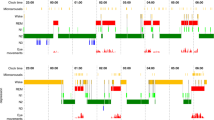Abstract
Ritanserin, a selective and potent serotonin-2 antagonist, is effective in the treatment of a variety of syndromes related to anxiety and depression, including dysthymic disorder. In animals and healthy volunteers, ritanserin specifically increases slow-wave sleep and the hypothesis arises that this effect on sleep may contribute to its therapeutic properties. Therefore, we studied the effects of ritanserin on sleep in a group of dysthymic patients (DSM-III). Polygraphic recording as well as subjective evaluations of the quality of sleep were performed before and at the end of a 4-week period of double-blind medication with either ritanserin (10 mg o.d. in the morning) or placebo. At baseline, patients showed at fragmented and superficial sleep, with low amounts of slow wave sleep. Ritanserin significantly increased Slow Wave Sleep and changed the frequency and distribution of some stage transitions during the night. No other sleep parameters were modified by ritanserin treatment.
Similar content being viewed by others
References
Adam K, Oswald I (1977) Sleep is for tissue restoration. J R Coll Physicians Lond 11:376–388
Arriaga F, Ruiz I, Lara E, Gelders Y (1986) Ritanserin, an original thymostenic for the treatment of dysthymia. A double-blind placebo-controlled study. Collegium Internationale Neuro-Psychopharmacologicum, 15th Congress, p 168 (Book of Abstracts)
Declerck AC, Wauquier A, Van der Ham-Veltman PHM, Gelders Y (1987) Increase in slow-wave sleep in humans with the serotonin-S2 antagonist ritanserin. Curr Ther Res 41(4):427–432
Dugovic C, Wauquier A (1987) 5-HT2 receptors could be primarily involved in the regulation of slow-wave sleep in the rat. Eur J Pharmacol 137:145–146
Feinberg M, Gillin JC, Carroll BJ, Greden JF, Zis AP (1982) EEG studies of sleep in the diagnosis of depression. Biol Psychiatry 17:305–316
Griffiths WJ, Lester BK, Coulter JD, Williams HL (1972) Trytophan and sleep in young adults. Psychophysiology 9:345–356
Guptka MA, Moldofsky H (1986) Dysthymic disorder and rheumatic pain modulation disorder (fibrositis syndrome): a comparison of symptoms and sleep physiology. Can J Psychiatry 31:608–616
Hartmann E, Cravens J, List S (1974) Hypnotic effects of l-tryptophan. Arch Gen Psychiatry 31:394–397
Idzikowsky C, Mills IJ, Glennard R (1986) 5-Hydroxytryptamine-2 antagonist increases human slow wave sleep. Brain Res 378:164–168
Koella WP (1984) The organization and regulation of sleep. Experientia 40:309–408
Leysen JE, Niemegeers CJE, Tollenaere JP, Laduron PM (1978) Serotoninergic component of neuroleptic receptors. Nature 272:168–171
Leysen JE, Gommeren W, Van Gompel P, Wynants J, Janssen P, Laduron PM (1985) Receptor binding properties in vitro and in vivo of ritanserin, a very potent and long acting serotonin-S2 antagonist. Mol Pharmacol 27:600–611
Oswald I, Adam K, Borrow S, Idzikowski C (1978) The effect of two hypnotics on sleep, subjective feelings and skilled performance. In: Passonant P, Oswald I (eds) Pharmacology of the states of alertness. Pergamon Press, Oxford, pp 583–586
Paiva T, Wauquier A, Arriaga F, Lara E, Pimentel T, Largo R (1986) Sleep profiles in dysthymic patients. Clin Neurol Neurosurg [Suppl I] 89:148
Peroutka SJ, Snyder SH (1979) Multiple serotonin receptors differential binding of [3 H]5-hydroxytryptamine, [3 H]lysergic acid diethylamide, and [3 H]spiroperidol. Mol Pharmacol 16:687–699
Rechtschaffen A, Kales A (1968) A manual of standardized terminology, techniques and scoring system for sleep stages of human subjects. US Government Printing Office, Washington DC
Reyntjens A, Gelders Y, Hoppenbrowers M-L JA, Vanden Bussche G (1986) Thymostenic effects of ritanserin (R 55667), a centrally acting serotonin-S2 receptor blocker. Drug Dev Res 8:205–211
Sokal RR, Rohlf FJ (1969) Biometry. Freeman, San Francisco
Sommerfelt L, Hauge ER, Ursin R (1987) Similar effect on REM sleep but differential effect on slow wave sleep of the two 5-HT uptake inhibitors ziurelidine and alaproclate in cats and rats. J Neural Transm 68:127–144
Author information
Authors and Affiliations
Rights and permissions
About this article
Cite this article
Paiva, T., Arriaga, F., Wauquier, A. et al. Effects of ritanserin on sleep disturbances of dysthymic patients. Psychopharmacology 96, 395–399 (1988). https://doi.org/10.1007/BF00216069
Received:
Revised:
Issue Date:
DOI: https://doi.org/10.1007/BF00216069



